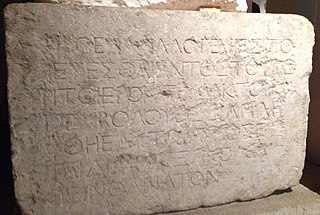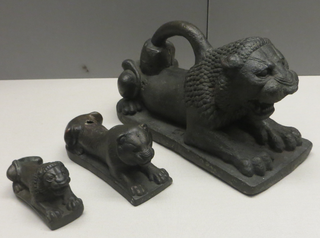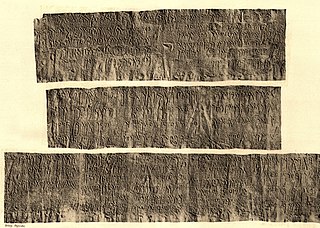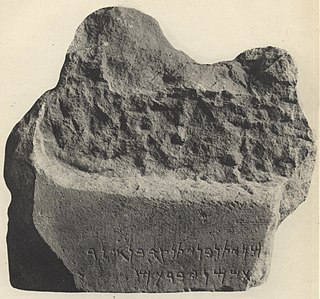
Gilles Vigneault is a Canadian poet, publisher, singer-songwriter, and Quebec nationalist and sovereigntist. Two of his songs are considered by many to be Quebec's unofficial anthems: "Mon pays" and "Gens du pays", and his line Mon pays ce n'est pas un pays, c'est l'hiver became a proverb in Quebec. Vigneault is a Grand Officer of the National Order of Quebec, Knight of the Legion of Honour, and Officer of the Ordre des Arts et des Lettres.
Hollywood Girls : Une nouvelle vie en Californie, or simply Hollywood Girls, is a French soap opera created by Alexandre dos Santos, Jérémy Michalak, and Thibaut Vales for NRJ12. The series features an ensemble cast and follows a groups of French peoples who decided to start a new life in California, but their life is quickly disrupted by the diabolical Geny G and her husband, the Dr. David Moretti.

The Temple Warning inscription, also known as the Temple Balustrade inscription or the Soreg inscription, is an inscription that hung along the balustrade outside the Sanctuary of the Second Temple in Jerusalem. Two of these tablets have been found. The inscription was a warning to pagan visitors to the temple not to proceed further. Both Greek and Latin inscriptions on the temple's balustrade served as warnings to pagan visitors not to proceed under penalty of death.

The Assyrian lion weights are a group of bronze statues of lions, discovered in archaeological excavations in or adjacent to ancient Assyria.

The Ramesses III prisoner tiles are a collection of Egyptian faience depicting prisoners of war, found in Ramesses III's palaces at Medinet Habu and Tell el-Yahudiyeh. Large numbers of faience tiles have been found in these areas by sebakh-diggers since 1903; the best known are those depicting foreign people or prisoners. Many were found in excavated rubbish heaps.

The Theodotos inscription is the earliest known inscription from a synagogue. It was found in December 1913 by Raymond Weill in Wadi Hilweh.
The Baal Lebanon inscription, known as KAI 31, is a Phoenician inscription found in Limassol, Cyprus in eight bronze fragments in the 1870s. At the time of their discovery, they were considered to be the second most important finds in Semitic palaeography after the Mesha stele.

The Corpus Inscriptionum Semiticarum is a collection of ancient inscriptions in Semitic languages produced since the end of 2nd millennium BC until the rise of Islam. It was published in Latin. In a note recovered after his death, Ernest Renan stated that: "Of all I have done, it is the Corpus I like the most."

The Yehawmilk stele, de Clercq stele, or Byblos stele, also known as KAI 10 and CIS I 1, is a Phoenician inscription from c.450 BC found in Byblos at the end of Ernest Renan's Mission de Phénicie. Yehawmilk, king of Byblos, dedicated the stele to the city’s protective goddess Ba'alat Gebal.

The Neirab steles are two 8th-century BC steles with Aramaic inscriptions found in 1891 in Al-Nayrab near Aleppo, Syria. They are currently in the Louvre. They were discovered in 1891 and acquired by Charles Simon Clermont-Ganneau for the Louvre on behalf of the Commission of the Corpus Inscriptionum Semiticarum. The steles are made of black basalt, and the inscriptions note that they were funerary steles. The inscriptions are known as KAI 225 and KAI 226.

The Maktar and Mididi inscriptions are a number of Punic language inscriptions, found in the 1890s at Maktar and Mididi, Tunisia. A number of the most notable inscriptions have been collected in Kanaanäische und Aramäische Inschriften, and are known as are known as KAI 145-158.

The Tayma stones, also Teima or Tema stones, were a number of Aramaic inscriptions found in Tayma, now northern Saudi Arabia. The first four inscriptions were found in 1878 and published in 1884, and included in the Corpus Inscriptionum Semiticarum II as numbers 113-116. In 1972, ten further inscriptions were published. In 1987 seven further inscriptions were published. Many of the inscriptions date to approximately the 5th and 6th centuries BCE.

The Cirta steles are almost 1,000 Punic funerary and votive steles found in Cirta in a cemetery located on a hill immediately south of the Salah Bey Viaduct.

The Ankh-Hapy stele is an Egyptian-Aramaic stele dated to 525–404 BCE. It was first published in a letter from François Lenormant to Ernest Renan in the Journal asiatique; Lenormant had noticed the stele in the Vatican collections and had brought a cast from Rome in 1860. Lenormant considered the stele to be reminiscent of the Carpentras Stele.
The Phoenician Adoration steles are a number of Phoenician and Punic steles depicting the adoration gesture (orans).

The Eshmun inscription is a Phoenician inscription on a fragment of grey-blue limestone found at the Temple of Eshmun in 1901. It is also known as RES 297. Some elements of the writing have been said to be similar to the Athenian Greek-Phoenician inscriptions. Today, it is held in the Museum of the Ancient Orient in Istanbul.

Hiram's Tomb is a large limestone sarcophagus and pedestal located approximately 6 km (3.7 mi) southeast of Tyre, Lebanon, near the village of Hanaouay on the road to Qana.

The Ain Nechma inscriptions, also known as the Guelma inscriptions are a number of Punic language inscriptions, first found in 1837 in the necropolis of Ain Nechma, in the Guelma Province of Algeria.
The Aadloun stele is a rock relief stele and inscription carved into the limestone rocks around the town of Aadloun in Lebanon, between Sidon and Tyre. Although heavily weathered when discovered in 1843, it was attributed to Ramesses II. It has been compared to the Stelae of Nahr el-Kalb approximately 60km to the north.

The Guelaât Bou Sbaâ Neopunic inscriptions are two Neopunic inscriptions – one bilingual with Latin – discovered in 1882–84 in Guelaât Bou Sbaâ, about 10 km from Guelma in Algeria.
















